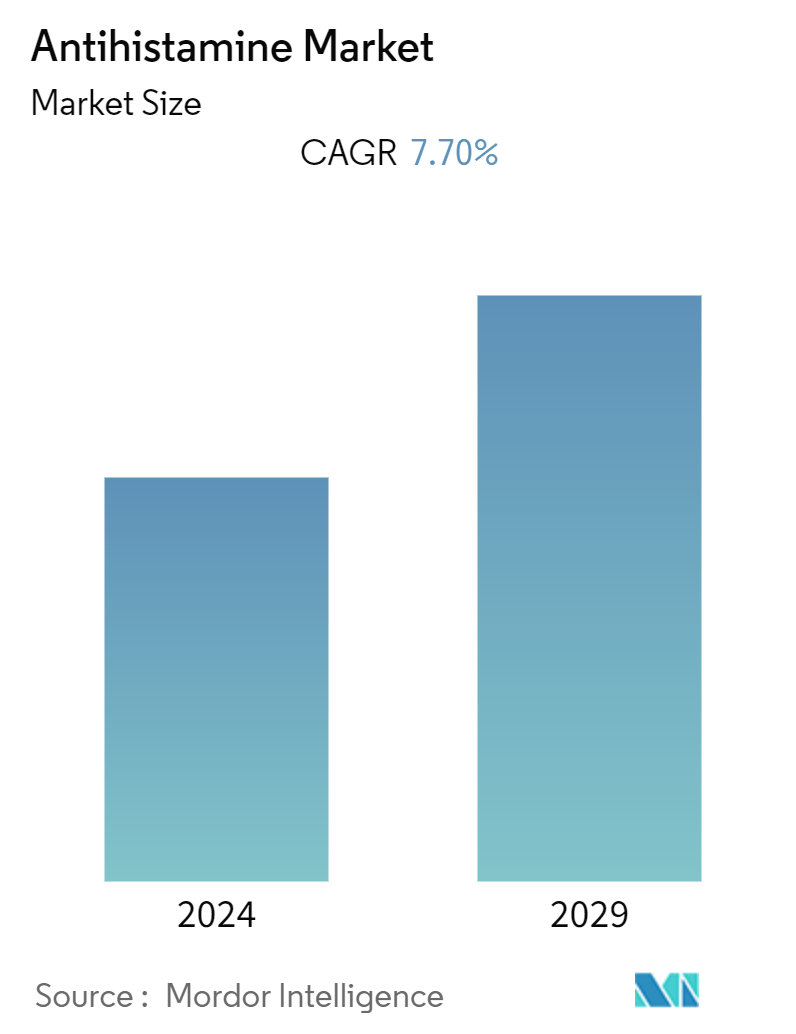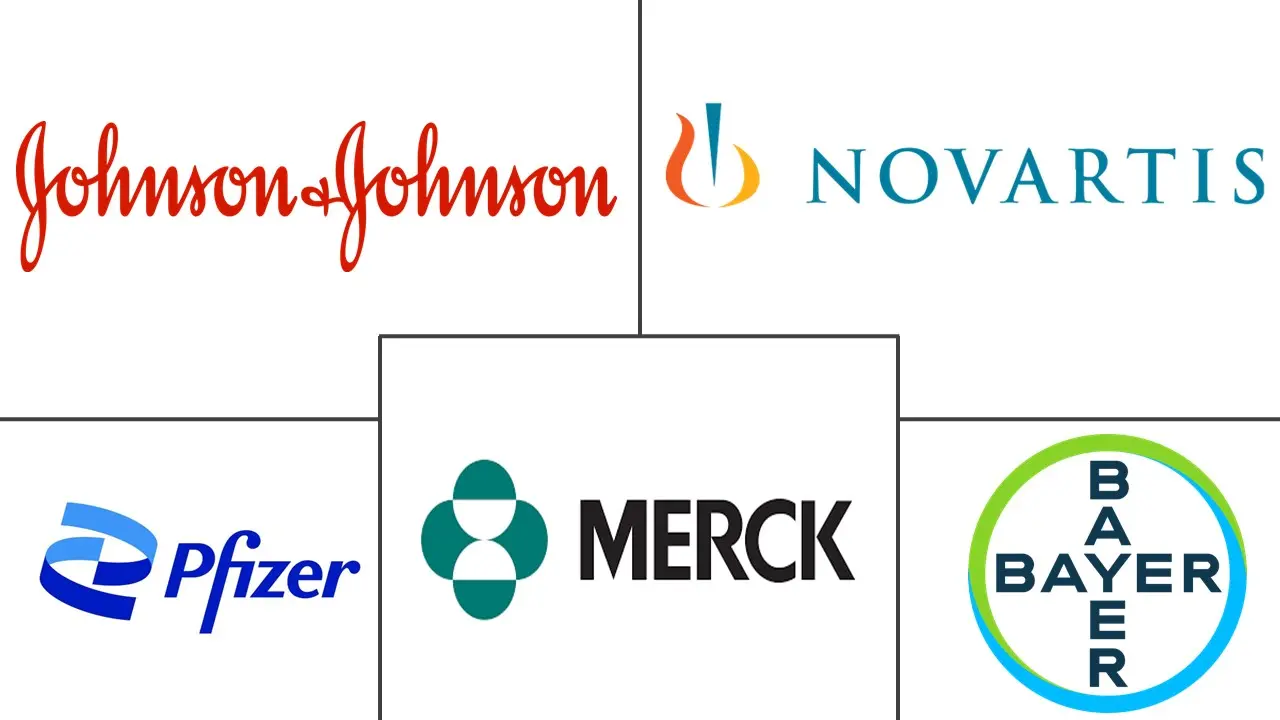Market Size of Antihistamine Industry

| Study Period | 2019 - 2029 |
| Base Year For Estimation | 2023 |
| CAGR (2024 - 2029) | 7.70 % |
| Fastest Growing Market | Asia Pacific |
| Largest Market | North America |
| Market Concentration | Low |
Major Players
*Disclaimer: Major Players sorted in no particular order |
Antihistamine Market Analysis
The Antihistamine Market is expected to register a CAGR of 7.70% during the forecast period.
The market’s growth is driven by factors like rising allergies and stomach disorders issues and increasing research and development activities for novel dosage forms. The rising burden of allergies and acid reflex are anticipated to drive the market's growth during the forecast period. For instance, according to the data published by the Asthma and Allergy Foundation of America in April 2024, nearly one-third of American adults and over a quarter of American children suffer from seasonal allergies, eczema, or food allergies each year.
According to a study published in Rawal Medical Journal in September 2022, the prevalence of gastroesophageal reflux disease (GERD) was found to be 18.1% to 27.8% in North America, 8.8% to 25.9% in Europe, 2.5% to 7.8% in East Asia, 8.7% to 33.1% in the Middle East, 11.6% in Australia, and 23% in South America. Therefore, such a massive prevalence of allergies and stomach disorders is anticipated to increase the demand for antihistamines, driving market growth.
Furthermore, companies’ strategic activities, such as collaborations and agreements in using antihistamine medications, are anticipated to bolster market growth during the forecast period. For instance, in March 2023, Astepro Allergy partnered with Meghann Fahy to help patients suffering from allergies. Astepro is a long-lasting nasal spray that starts working in 30 minutes and can relieve allergy symptoms quickly. Therefore, such partnerships increase the usage of antihistamines, which is anticipated to increase their adoption among people and drive market growth.
Therefore, the rising issues of allergies and stomach disorders and the company's strategic activities are anticipated to drive market growth. However, the patent expiry of branded drugs, the introduction of generic drugs, and the adverse effects associated with antihistamine drugs are impeding market growth.
Antihistamine Industry Segmentation
As per the report's scope, antihistamines, a common medication class, are primarily employed to alleviate allergy symptoms. They combat conditions triggered by the body's overproduction of histamine, an immune system byproduct. Predominantly, antihistamines cater to individuals grappling with allergic responses to pollen and other allergens. Beyond allergies, they find utility in managing a spectrum of conditions, spanning from anxiety and colds to gastrointestinal maladies.
The antihistamine market is segmented by drug class, dosage form, type, disease, distribution channels, and geography. By drug class, the market is segmented into H1 antihistamines, H2 antihistamines, and H3 antihistamines. The H1 antihistamines segment is sub-segmented into first-generation and second-generation. By dosage form, the market is segmented into oral route, parenteral route, and other dosage forms. By type, the market is segmented into OTC and prescription-based. By disease, the market is segmented into allergic disorders, stomach disorders, central nervous system disorders, and other diseases. By distribution channels, the market is segmented into hospital pharmacies, retail pharmacies, and online pharmacies. By geography, the market is segmented into North America, Europe, Asia-Pacific, Middle East and Africa, and South America. The market report also covers the estimated market sizes and trends for 17 countries across major global regions. The report offers the value (USD) for the above segments.
| By Drug Class | ||||
| ||||
| H2 Anti histamanics | ||||
| H3 Anti histamanics |
| By Dosage Form | |
| Oral route | |
| Parenteral | |
| Other Dosage Forms |
| By Type | |
| OTC | |
| Prescription-based |
| By Disease | |
| Allergic Disorders | |
| Stomach Disorders | |
| Central Nervous System Disorders | |
| Other Diseases |
| By Distribution Channels | |
| Hospital Pharmacies | |
| Retail Pharmacies | |
| Online Pharmacies |
| By Geography | ||||||||
| ||||||||
| ||||||||
| ||||||||
| ||||||||
|
Antihistamine Market Size Summary
The antihistamine market is poised for significant growth, driven by the increasing prevalence of allergies and stomach disorders, alongside heightened research and development activities aimed at novel dosage forms. The rising incidence of allergic conditions, such as seasonal allergies and food allergies, is a major factor propelling market expansion. Additionally, the prevalence of gastroesophageal reflux disease (GERD) across various regions further fuels the demand for antihistamines. Strategic initiatives by companies, including collaborations and product launches, are expected to enhance market penetration and adoption. However, challenges such as patent expirations, the introduction of generic drugs, and potential adverse effects of antihistamines may impede market growth.
Regionally, North America is anticipated to maintain a significant market share due to the high incidence of allergies, a robust presence of key market players, and supportive healthcare infrastructure. The region's market growth is further bolstered by government funding for research and development in allergic disorders and the approval of new antihistamine medications. The fragmented nature of the market, with numerous players like Johnson and Johnson, Novartis AG, and Pfizer Inc. actively participating, contributes to the competitive landscape. These companies are engaged in various initiatives, including product launches and partnerships, to strengthen their market position and drive growth.
Antihistamine Market Size - Table of Contents
-
1. MARKET DYNAMICS
-
1.1 Market Overview
-
1.2 Market Drivers
-
1.2.1 Rising Issues of Allergies and Stomach Disorders
-
1.2.2 Increase in R&D Activities Leading to Development of Novel Dosage Forms
-
1.2.3
-
-
1.3 Market Restraints
-
1.3.1 Patent Expiry and Introduction of Generic Drugs
-
1.3.2 Adverse Effects Associated with Antihistamine Drugs
-
-
1.4 Porter's Five Forces Analysis
-
1.4.1 Threat of New Entrants
-
1.4.2 Bargaining Power of Buyers/Consumers
-
1.4.3 Bargaining Power of Suppliers
-
1.4.4 Threat of Substitute Products
-
1.4.5 Intensity of Competitive Rivalry
-
-
-
2. MARKET SEGMENTATION (Market Size by Value - USD)
-
2.1 By Drug Class
-
2.1.1 H1 Antihistamanics
-
2.1.1.1 First Generation
-
2.1.1.2 Second Generation
-
-
2.1.2 H2 Anti histamanics
-
2.1.3 H3 Anti histamanics
-
-
2.2 By Dosage Form
-
2.2.1 Oral route
-
2.2.2 Parenteral
-
2.2.3 Other Dosage Forms
-
-
2.3 By Type
-
2.3.1 OTC
-
2.3.2 Prescription-based
-
-
2.4 By Disease
-
2.4.1 Allergic Disorders
-
2.4.2 Stomach Disorders
-
2.4.3 Central Nervous System Disorders
-
2.4.4 Other Diseases
-
-
2.5 By Distribution Channels
-
2.5.1 Hospital Pharmacies
-
2.5.2 Retail Pharmacies
-
2.5.3 Online Pharmacies
-
-
2.6 By Geography
-
2.6.1 North America
-
2.6.1.1 United States
-
2.6.1.2 Canada
-
2.6.1.3 Mexico
-
-
2.6.2 Europe
-
2.6.2.1 Germany
-
2.6.2.2 United Kingdom
-
2.6.2.3 France
-
2.6.2.4 Italy
-
2.6.2.5 Spain
-
2.6.2.6 Rest of Europe
-
-
2.6.3 Asia-Pacific
-
2.6.3.1 China
-
2.6.3.2 Japan
-
2.6.3.3 India
-
2.6.3.4 Australia
-
2.6.3.5 South Korea
-
2.6.3.6 Rest of Asia-Pacific
-
-
2.6.4 Middle East and Africa
-
2.6.4.1 GCC
-
2.6.4.2 South Africa
-
2.6.4.3 Rest of Middle East and Africa
-
-
2.6.5 South America
-
2.6.5.1 Brazil
-
2.6.5.2 Argentina
-
2.6.5.3 Rest of South America
-
-
-
Antihistamine Market Size FAQs
What is the current Antihistamine Market size?
The Antihistamine Market is projected to register a CAGR of 7.70% during the forecast period (2024-2029)
Who are the key players in Antihistamine Market?
Johnson and Johnson, Novartis, Pfizer, Merck and Co. and Bayer are the major companies operating in the Antihistamine Market.

